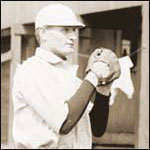|
|

|
Pittsburgh Post-Gazette
by Gene Collier, Sports Columnist
BEFORE THE BABE,
THERE WAS PROSPECT'S ZANY RUBE
Early tomorrow morning in Prospect, the little town west of Butler, they'll be dedicating an historical marker that is just as reliably an hysterical marker, as it honors the life and career of baseball's original superflake, one George Edward "Rube" Waddell.
Long forgotten by the latter half of the 20th century, Waddell was arguably the most compelling and colorful figure of what might be called the game's pre-history, by which I mean before Babe Ruth. It was not terribly unusual, for example, for Waddell, a strapping left-handed pitcher, to go into his stretch move, come to the belt, check the runners, and sprint from the mound to chase a passing fire engine.
He occasionally missed his turn in the rotation because he was playing marbles with kids. Some teammates doubtless found that ironic in that Rube had long since lost his.
Born in Bradford in 1876, Waddell moved with his family as his father, John, chased the burgeoning fortunes of the oil industry, finally settling in Prospect. There, Rube Waddell cultivated a Bunyanesque working man's legend in the oil fields and first tried his physical gifts on a baseball diamond. Between then and his induction into the Baseball Hall of Fame, posthumously in 1946, lies a story Hollywood could turn into a product that would outrun Seabiscuit.
At least Dan O'Brien, who has written a Rube Waddell screenplay and will be a guest speaker at the ceremonies tomorrow, certainly hopes so.
O'Brien, a former sports producer at Channel 11 in the Sam Nover-Rocky Bleier era that seems almost as ancient as the Rube Waddell era, has been captivated by Waddell's life since he started poking around at the research about 10 years ago.
"I'd actually been fascinated with Rube Waddell since I was a kid because I read that he was a pitcher who wrestled alligators, but I just thought he was this lovable eccentric," O'Brien said from his home in Indianapolis yesterday. "I did not realize the whole potential of the story or the incredible impact he had on baseball. He was baseball's biggest drawing card in the first decade of the century. He was even more colorful than the Babe.
"He bounced around from team to team (including parts of two seasons with the Pirates, 1900 and 1901), but when he landed with Connie Mack in Philadelphia the next season, he had found someone who could handle him. Mack had a reputation for being able to handle flakes, and he gave Rube a pretty long leash. He convinced his team that Rube was such a draw that he was effectively paying part of their salaries. Teammates generally liked Rube, even though he could be frustrating and even infuriating."
There are surely enough Rube stories to fill a screenplay and a book (O'Brien's doing that, too), but the best go to Waddell's love of the dramatic and the heroic. In exhibition games, he would sometimes walk the bases loaded, dismiss his fielders, then strike out the side. If baseball's exhaustive statistical history proves anything about him, it was he could flat strike people out.
Connie Mack, the game's greatest manager, considered him his favorite player, saying he combined the most effective combination of power and finesse in a pitcher that he'd ever seen. In 1902, when foul balls were not counted as strikes, Waddell fanned 210 hitters after joining the A's in mid-season and pitching them from fourth to first in the American League. In 1905, when he led them to one of the two world championships that marked his tenure, he struck out 349 hitters, a single-season record that stood until Sandy Koufax broke it 60 years later. He pitched dozens of complete games every summer. In an agreement with Mack, he'd pitch doubleheaders and then take three days off to go fishing . And he would disappear for days at a time to be a fire fighter.
"When I got to the ballpark," Mack once said, "I'd look first to the flagpole to see which way the wind was blowing, and then to the dugout to see if Waddell had showed up."
Though Waddell's drinking was intensely documented, O'Brien believes it was overstated. In a Pittsburgh Press obituary from 1914, Waddell was particularly remembered for a stunt he had hoped would get him off-season work as a circus strong man while he was under contract to the Pirates. He would rip open his shirt and let four people stand on his chest, then lift himself into a kind of human bridge. This he once executed, according to the writer, "in a Fourth Avenue wet goods emporium (where) a quartet of the female species were the first aids to the big boob."
I think that means four women stood on his chest in a bar.
It was that obituary and a second from a paper in Milwaukee that credited Waddell with saving the American League with his performance for the 1902 A's. The American League had just withstood a torrent of bad publicity for raiding National League clubs, but Waddell's antics and athleticism kept the crowds coming in.
"My favorite stories are the ones that play like Greek tragedy," said O'Brien. "He had the classic flaws of the mythological hero. He had an Achilles brain. He was a legitimate hero, standing in the flood waters trying to build a sand bag wall to save a small town in Kentucky, which ultimately led to his death at age 37. He was born on Friday the 13th and died on April Fool's Day. When it gets to the big screen, people will say, 'Aw, that's just Hollywood.'"
Gene Collier can be reached at gcollier@post-gazette.com or 412-263-1283.